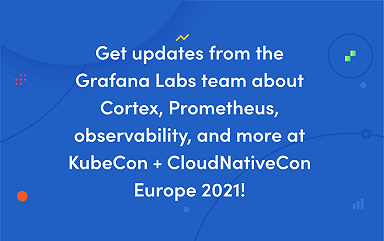
What's next in Kubernetes monitoring, Prometheus histograms, observability, and more: KubeCon EU 2022 in review
In May, a team from Grafana Labs descended on Valencia, Spain, to share their latest insights on the cloud native landscape at KubeCon + CloudNativeCon EU 2022.
Along with diving into the future of Kubernetes monitoring with kubectl alpha events and multi-cloud deployments, Grafanistas presented an overview of the Prometheus ecosystem with an eye towards how sparse high-resolution histograms are going to change the game. There was also a discussion on the future of observability and how you can help shape that.
Now you can check out all the talks given by our Grafana Labs experts at KubeCon EU 2022.
The soul of a new command: Adding ‘Events’ to kubectl
Introduced as an alpha feature in the Kubernetes 1.23 release, the kubectl alpha events command resolves some issues that could not be fixed within the generic kubectl get command. Grafana Labs Distinguished Engineer Bryan Boreham provides insight as to how the need for kubectl events came about and how he got involved in its development. The session also focuses on the lifecycle of a Kubernetes enhancement, how a kubectl command is structured, plus gives a look at the possible future for kubectl [alpha] events.
Prometheus intro and deep dive
Grafana Labs Engineer Björn “Beorn” Rabenstein joined his fellow Prometheus project maintainers to provide an introduction to Prometheus, followed by a deep dive into the exciting new features that have been released recently or are in the pipeline. You will learn about the many opportunities to use Prometheus — and perhaps be tempted to contribute to the project yourself.
Alerting in the Prometheus ecosystem: The past, present and future
One of the most important functionalities of Prometheus is being able to alert based on your metrics. The Prometheus Alertmanager is a critical piece of cloud native observability, and in this talk, Grafana Labs Software Engineer Josue (Josh) Abreu shares a bit more about how, roughly a year ago, he set out on a path to improve scaling in the Cortex Alertmanager component. He then decided to include the Alertmanager within Grafana to continue fostering open source collaboration. For the future, his plan is to take all the good parts of what he learned on this journey back to the Prometheus Alertmanager, thus going full circle.
Prometheus sparse high-resolution histograms in action
Sparse high-resolution histograms are going to totally revamp how Prometheus works with histograms. For the first time, you can witness a complete working setup, from instrumentation over ingestion, storage, and querying all the way to graphical representation. Grafana Labs Senior Software Engineer Ganesh Vernekar demonstrates the breathtaking possibilities of these histograms, which include precise quantile estimations and high-resolution heatmaps, both aggregated and partitioned at will, even if, over time or between different targets, histograms of different resolutions are involved.
What is the CNCF TAG Observability and how you can join our effort!
The Technical Advisory Groups (TAGs, formerly SIGs) were created by the CNCF to help provide technical guidance and expertise across projects pertaining to a specific domain. One of the domains that is in demand and shows great innovation within the cloud native ecosystem is observability. In this talk, Grafana Labs Director of Community and CNCF Technical Advisory Group Observability chair Richard “RichiH” Hartmann joins other TAG Observability team members to explain what they are responsible for, how you can contribute, and where to find them. Also the team shares what has been done so far and how you can join in the efforts to improve the observability ecosystem around us — including looking for a diversity of skills and backgrounds so they can provide more supporting materials and best practices for end users and contributors around monitoring and observability.
Kubernetes everywhere: Lessons learned from running multi-cloud
Many companies are interested in deploying their products across multiple cloud providers, but few actually see it through. While benefits like avoiding provider lock-in and increased uptime during provider outages are attractive, several factors are important to consider. Grafana Labs successfully deployed across AWS, Azure, DigitalOcean, GCP, and Linode in more than 30 regions; that includes inter-cloud network connections. Grafana Labs Site Reliability Engineer Niko Smeds explores some of the large and subtle differences in networking and managed Kubernetes services between said providers. He discusses the approaches we took while scaling our infrastructure across multiple environments, the challenges we faced, and what worked in the end.
To learn more about how you can get started with Kubernetes monitoring in Grafana Cloud, go to our Kubernetes Monitoring solutions page.
For more great talks from our Grafana Labs experts and community members, join us for GrafanaCONline 2022 from June 13-17. Register for free today!


